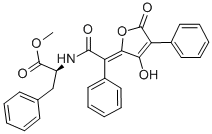2-PHENYL-2-BUTENAL
Synonym(s):cocoa butenal
- CAS NO.:4411-89-6
- Empirical Formula: C10H10O
- Molecular Weight: 146.19
- MDL number: MFCD00053158
- EINECS: 224-567-0
- SAFETY DATA SHEET (SDS)
- Update Date: 2024-12-18 13:37:16

What is 2-PHENYL-2-BUTENAL?
Chemical properties
2-Phenyl-2-butenal has a green, floral, woody aroma
Occurrence
Reported as the odorous component in black tea and Phallus impudicus. Also reported found in cocoa, roasted hazelnut, asparagus, coffee, cocoa, microbial fermented tea, roasted filbert, American potato chips, soybean, rice bran, malt, katsuobishi (dried bonito), okra, roasted macadamia nut and roasted sesame seeds.
The Uses of 2-PHENYL-2-BUTENAL
2-Phenyl-2-butenal can be used to compare acrylamide and furan concentrations, antioxidant activities, and volatility profiles in cold or hot coffees.
Preparation
From acetaldehyde and phenyl acetaldehyde.
Definition
ChEBI: 2-Phenyl-2-butenal is an olefinic compound.
Taste threshold values
Taste characteristics at 10 ppm: green, vegetative, floral, cocoa and nutty.
Properties of 2-PHENYL-2-BUTENAL
| Boiling point: | 177 °C15 mm Hg(lit.) |
| Density | 1.034 g/mL at 25 °C(lit.) |
| refractive index | n |
| FEMA | 3224 | 2-PHENYL-2-BUTENAL |
| Flash point: | 222 °F |
| Specific Gravity | 1.03 |
| Odor | at 100.00 %. sweet narcissus cortex beany honey cocoa nutty radish |
| Water Solubility | Soluble in oil and ethanol. Insoluble in water. |
| Sensitive | Air Sensitive |
| JECFA Number | 1474 |
| CAS DataBase Reference | 4411-89-6(CAS DataBase Reference) |
| EPA Substance Registry System | Benzeneacetaldehyde, .alpha.-ethylidene- (4411-89-6) |
Safety information for 2-PHENYL-2-BUTENAL
| Signal word | Warning |
| Pictogram(s) |
 Exclamation Mark Irritant GHS07 |
| GHS Hazard Statements |
H315:Skin corrosion/irritation H319:Serious eye damage/eye irritation H335:Specific target organ toxicity, single exposure;Respiratory tract irritation |
| Precautionary Statement Codes |
P261:Avoid breathing dust/fume/gas/mist/vapours/spray. P264:Wash hands thoroughly after handling. P264:Wash skin thouroughly after handling. P271:Use only outdoors or in a well-ventilated area. P280:Wear protective gloves/protective clothing/eye protection/face protection. P302+P352:IF ON SKIN: wash with plenty of soap and water. P305+P351+P338:IF IN EYES: Rinse cautiously with water for several minutes. Remove contact lenses, if present and easy to do. Continuerinsing. |
Computed Descriptors for 2-PHENYL-2-BUTENAL
New Products
(S)-3-Aminobutanenitrile hydrochloride 4-Methylphenylacetic acid N-Boc-D-alaninol N-BOC-D/L-ALANINOL Tert-butyl bis(2-chloroethyl)carbamate 3-Morpholino-1-(4-nitrophenyl)-5,6-dihydropyridin- 2(1H)-one Furan-2,5-Dicarboxylic Acid Tropic acid 1-Bromo-3,5-Di-Tert-Butylbenzene S-2-CHLORO PROPIONIC ACID ETHYL ISOCYANOACETATE 2-Bromo-1,3-Bis(Dimethylamino)Trimethinium Hexafluorophosphate 4-IODO BENZOIC ACID 3-NITRO-2-METHYL ANILINE 1-(2,4-DICHLOROPHENYL) ETHANAMINE (2-Hydroxyphenyl)acetonitrile 4-Bromopyrazole 2-(Cyanocyclohexyl)acetic acid 4-methoxy-3,5-dinitropyridine 1-(4-(aminomethyl)benzyl)urea hydrochloride 2-aminopropyl benzoate hydrochloride diethyl 2-(2-((tertbutoxycarbonyl)amino) ethyl)malonate tert-butyl 4- (ureidomethyl)benzylcarbamate Ethyl-2-chloro((4-methoxyphenyl)hydrazono)acetateRelated products of tetrahydrofuran








You may like
-
 2033-24-1 98%View Details
2033-24-1 98%View Details
2033-24-1 -
 42831-50-5 5-METHYLISOXAZOLE-4-CARBOXYLIC ACID 98%View Details
42831-50-5 5-METHYLISOXAZOLE-4-CARBOXYLIC ACID 98%View Details
42831-50-5 -
 1975-50-4 98%View Details
1975-50-4 98%View Details
1975-50-4 -
 2-HYDROXY BENZYL ALCOHOL 98%View Details
2-HYDROXY BENZYL ALCOHOL 98%View Details
90-01-7 -
 2-Chloro-1,3-Bis(Dimethylamino)Trimethinium Hexafluorophosphate 221615-75-4 98%View Details
2-Chloro-1,3-Bis(Dimethylamino)Trimethinium Hexafluorophosphate 221615-75-4 98%View Details
221615-75-4 -
 61397-56-6 CIS BROMO BENZOATE 98%View Details
61397-56-6 CIS BROMO BENZOATE 98%View Details
61397-56-6 -
 14714-50-2 (2-Hydroxyphenyl)acetonitrile 98+View Details
14714-50-2 (2-Hydroxyphenyl)acetonitrile 98+View Details
14714-50-2 -
 118753-70-1 98+View Details
118753-70-1 98+View Details
118753-70-1
Statement: All products displayed on this website are only used for non medical purposes such as industrial applications or scientific research, and cannot be used for clinical diagnosis or treatment of humans or animals. They are not medicinal or edible.